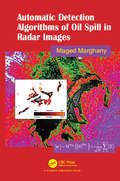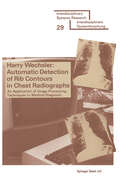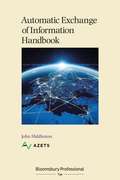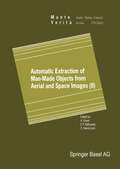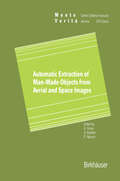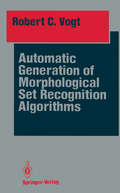- Table View
- List View
Automatic Defense Against Zero-day Polymorphic Worms in Communication Networks
by Mohssen Mohammed Al-Sakib Khan PathanAble to propagate quickly and change their payload with each infection, polymorphic worms have been able to evade even the most advanced intrusion detection systems (IDS). And, because zero-day worms require only seconds to launch flooding attacks on your servers, using traditional methods such as manually creating and storing signatures to de
Automatic Design of Decision-Tree Induction Algorithms (SpringerBriefs in Computer Science)
by Rodrigo C. Barros André C.P.L.F de Carvalho Alex A. FreitasPresents a detailed study of the major design components that constitute a top-down decision-tree induction algorithm, including aspects such as split criteria, stopping criteria, pruning and the approaches for dealing with missing values. Whereas the strategy still employed nowadays is to use a 'generic' decision-tree induction algorithm regardless of the data, the authors argue on the benefits that a bias-fitting strategy could bring to decision-tree induction, in which the ultimate goal is the automatic generation of a decision-tree induction algorithm tailored to the application domain of interest. For such, they discuss how one can effectively discover the most suitable set of components of decision-tree induction algorithms to deal with a wide variety of applications through the paradigm of evolutionary computation, following the emergence of a novel field called hyper-heuristics."Automatic Design of Decision-Tree Induction Algorithms" would be highly useful for machine learning and evolutionary computation students and researchers alike.
Automatic Detection Algorithms of Oil Spill in Radar Images
by Maged MarghanySynthetic Aperture Radar Automatic Detection Algorithms (SARADA) for Oil Spills conveys the pivotal tool required to fully comprehend the advanced algorithms in radar monitoring and detection of oil spills, particularly quantum computing and algorithms as a keystone to comprehending theories and algorithms behind radar imaging and detection of marine pollution. Bridging the gap between modern quantum mechanics and computing detection algorithms of oil spills, this book contains precise theories and techniques for automatic identification of oil spills from SAR measurements. Based on modern quantum physics, the book also includes the novel theory on radar imaging mechanism of oil spills. With the use of precise quantum simulation of trajectory movements of oil spills using a sequence of radar images, this book demonstrates the use of SARADA for contamination by oil spills as a promising novel technique. Key Features: Introduces basic concepts of a radar remote sensing. Fills a gap in the knowledge base of quantum theory and microwave remote sensing. Discusses the important aspects of oil spill imaging in radar data in relation to the quantum theory. Provides recent developments and progresses of automatic detection algorithms of oil spill from radar data. Presents 2-D oil spill radar data in 4-D images.
Automatic Detection Algorithms of Oil Spill in Radar Images
by Maged MarghanySynthetic Aperture Radar Automatic Detection Algorithms (SARADA) for Oil Spills conveys the pivotal tool required to fully comprehend the advanced algorithms in radar monitoring and detection of oil spills, particularly quantum computing and algorithms as a keystone to comprehending theories and algorithms behind radar imaging and detection of marine pollution. Bridging the gap between modern quantum mechanics and computing detection algorithms of oil spills, this book contains precise theories and techniques for automatic identification of oil spills from SAR measurements. Based on modern quantum physics, the book also includes the novel theory on radar imaging mechanism of oil spills. With the use of precise quantum simulation of trajectory movements of oil spills using a sequence of radar images, this book demonstrates the use of SARADA for contamination by oil spills as a promising novel technique. Key Features: Introduces basic concepts of a radar remote sensing. Fills a gap in the knowledge base of quantum theory and microwave remote sensing. Discusses the important aspects of oil spill imaging in radar data in relation to the quantum theory. Provides recent developments and progresses of automatic detection algorithms of oil spill from radar data. Presents 2-D oil spill radar data in 4-D images.
Automatic Detection of Irony: Opinion Mining in Microblogs and Social Media
by Jihen Karoui Farah Benamara Veronique MoriceauIn recent years, there has been a proliferation of opinion-heavy texts on the Web: opinions of Internet users, comments on social networks, etc. Automating the synthesis of opinions has become crucial to gaining an overview on a given topic. Current automatic systems perform well on classifying the subjective or objective character of a document. However, classifications obtained from polarity analysis remain inconclusive, due to the algorithms' inability to understand the subtleties of human language. Automatic Detection of Irony presents, in three stages, a supervised learning approach to predicting whether a tweet is ironic or not. The book begins by analyzing some everyday examples of irony and presenting a reference corpus. It then develops an automatic irony detection model for French tweets that exploits semantic traits and extralinguistic context. Finally, it presents a study of portability in a multilingual framework (Italian, English, Arabic).
Automatic Detection of Irony: Opinion Mining in Microblogs and Social Media
by Jihen Karoui Farah Benamara Veronique MoriceauIn recent years, there has been a proliferation of opinion-heavy texts on the Web: opinions of Internet users, comments on social networks, etc. Automating the synthesis of opinions has become crucial to gaining an overview on a given topic. Current automatic systems perform well on classifying the subjective or objective character of a document. However, classifications obtained from polarity analysis remain inconclusive, due to the algorithms' inability to understand the subtleties of human language. Automatic Detection of Irony presents, in three stages, a supervised learning approach to predicting whether a tweet is ironic or not. The book begins by analyzing some everyday examples of irony and presenting a reference corpus. It then develops an automatic irony detection model for French tweets that exploits semantic traits and extralinguistic context. Finally, it presents a study of portability in a multilingual framework (Italian, English, Arabic).
Automatic Detection of Rib Contours in Chest Radiographs: An Application of Image Processing Techniques in Medical Diagnosis (Interdisciplinary Systems Research)
by WECHSLER1.1 Statement of the Problem This work describes a new and effective computer algorithm for detecting the contours of ribs in ehest radiographs. The problem, which is common to both the research areas of Machine Vision and Biomedical Computing, is to extract graphical information, such as that represented in Figure 1-lb, from a picture such as Figure 1-la. Figure 1-la shows a typical posterior-anterior (PA) ehest radiograph while Figure 1-lb shows a drawing of the ventral aspect of the thorax. lt is hoped that this researchwill contribute significantly toward developing an automated system for interpreting ehest radio graphs. 1.2 Why Have We Carried Out This Research? Since about one-third of the 650,000,000 medical radiographs (X-ray photographs) taken annually in the United States areehest radiographs, there is a growing awareness of the need for a computer aided system to help diagnose these radiographs. The detection of rib contours is, of course, a necessary element in such a system. In addition to being able to accommodate the need for a mass screening program, an automated systemalso has the ability to detect anomalies at earlier stages. Ziskin et al (1971) state that reliable 2 {a) Original Chest Radiograph Figure 1-1. A Chest Radiograph 3 VENTRAL CONTOUR CARTILAGE {b) THE THORAX; VENTRAL ASPECT OF A CHEST RADIOGRAPH Figura 1-1 A CHEST RADIOGRAPH studies indicate that even under routine conditions radiologists fail to detect approximately 30% of abnormalities in ehest X-ray films.
Automatic Detection of Verbal Deception (Synthesis Lectures on Human Language Technologies)
by Eileen Fitzpatrick Joan Bachenko Tommaso FornaciariThe attempt to spot deception through its correlates in human behavior has a long history. Until recently, these efforts have concentrated on identifying individual "cues" that might occur with deception. However, with the advent of computational means to analyze language and other human behavior, we now have the ability to determine whether there are consistent clusters of differences in behavior that might be associated with a false statement as opposed to a true one. While its focus is on verbal behavior, this book describes a range of behaviors—physiological, gestural as well as verbal—that have been proposed as indicators of deception. An overview of the primary psychological and cognitive theories that have been offered as explanations of deceptive behaviors gives context for the description of specific behaviors. The book also addresses the differences between data collected in a laboratory and "real-world" data with respect to the emotional and cognitive state of the liar. It discusses sources of real-world data and problematic issues in its collection and identifies the primary areas in which applied studies based on real-world data are critical, including police, security, border crossing, customs, and asylum interviews; congressional hearings; financial reporting; legal depositions; human resource evaluation; predatory communications that include Internet scams, identity theft, and fraud; and false product reviews. Having established the background, this book concentrates on computational analyses of deceptive verbal behavior that have enabled the field of deception studies to move from individual cues to overall differences in behavior. The computational work is organized around the features used for classification from ����-gram through syntax to predicate-argument and rhetorical structure. The book concludes with a set of open questions that the computational work has generated.
Automatic Differentiation: (pdf) (Lecture Notes in Computational Science and Engineering #50)
by H. Martin Bücker George Corliss Paul Hovland Uwe Naumann Boyana NorrisAutomatic Differentiation of Algorithms: From Simulation to Optimization
by George Corliss Christele Faure Andreas Griewank Laurent Hascoet Uwe NaumannA survey book focusing on the key relationships and synergies between automatic differentiation (AD) tools and other software tools, such as compilers and parallelizers, as well as their applications. The key objective is to survey the field and present the recent developments. In doing so the topics covered shed light on a variety of perspectives. They reflect the mathematical aspects, such as the differentiation of iterative processes, and the analysis of nonsmooth code. They cover the scientific programming aspects, such as the use of adjoints in optimization and the propagation of rounding errors. They also cover "implementation" problems.
Automatic Digital Document Processing and Management: Problems, Algorithms and Techniques (Advances in Computer Vision and Pattern Recognition)
by Stefano FerilliThis text reviews the issues involved in handling and processing digital documents. Examining the full range of a document’s lifetime, the book covers acquisition, representation, security, pre-processing, layout analysis, understanding, analysis of single components, information extraction, filing, indexing and retrieval. Features: provides a list of acronyms and a glossary of technical terms; contains appendices covering key concepts in machine learning, and providing a case study on building an intelligent system for digital document and library management; discusses issues of security, and legal aspects of digital documents; examines core issues of document image analysis, and image processing techniques of particular relevance to digitized documents; reviews the resources available for natural language processing, in addition to techniques of linguistic analysis for content handling; investigates methods for extracting and retrieving data/information from a document.
Automatic Disambiguation of Author Names in Bibliographic Repositories (Synthesis Lectures on Information Concepts, Retrieval, and Services)
by Anderson A. Ferreira Marcos André Gonçalves Alberto H. LaenderThis book deals with a hard problem that is inherent to human language: ambiguity. In particular, we focus on author name ambiguity, a type of ambiguity that exists in digital bibliographic repositories, which occurs when an author publishes works under distinct names or distinct authors publish works under similar names. This problem may be caused by a number of reasons, including the lack of standards and common practices, and the decentralized generation of bibliographic content. As a consequence, the quality of the main services of digital bibliographic repositories such as search, browsing, and recommendation may be severely affected by author name ambiguity. The focal point of the book is on automatic methods, since manual solutions do not scale to the size of the current repositories or the speed in which they are updated. Accordingly, we provide an ample view on the problem of automatic disambiguation of author names, summarizing the results of more than a decade of research on this topic conducted by our group, which were reported in more than a dozen publications that received over 900 citations so far, according to Google Scholar. We start by discussing its motivational issues (Chapter 1). Next, we formally define the author name disambiguation task (Chapter 2) and use this formalization to provide a brief, taxonomically organized, overview of the literature on the topic (Chapter 3). We then organize, summarize and integrate the efforts of our own group on developing solutions for the problem that have historically produced state-of-the-art (by the time of their proposals) results in terms of the quality of the disambiguation results. Thus, Chapter 4 covers HHC - Heuristic-based Clustering, an author name disambiguation method that is based on two specific real-world assumptions regarding scientific authorship. Then, Chapter 5 describes SAND - Self-training Author Name Disambiguator and Chapter 6 presents two incremental author name disambiguation methods, namely INDi - Incremental Unsupervised Name Disambiguation and INC- Incremental Nearest Cluster. Finally, Chapter 7 provides an overview of recent author name disambiguation methods that address new specific approaches such as graph-based representations, alternative predefined similarity functions, visualization facilities and approaches based on artificial neural networks. The chapters are followed by three appendices that cover, respectively: (i) a pattern matching function for comparing proper names and used by some of the methods addressed in this book; (ii) a tool for generating synthetic collections of citation records for distinct experimental tasks; and (iii) a number of datasets commonly used to evaluate author name disambiguation methods. In summary, the book organizes a large body of knowledge and work in the area of author name disambiguation in the last decade, hoping to consolidate a solid basis for future developments in the field.
Automatic Exchange of Information Handbook
by John HiddlestonAutomatic Exchange of Information Handbook is a practical guide to the automatic exchange of information rules legislation within the UK. Covering the requirements of the OECD Common Reporting Standard (CRS), and the US Foreign Account Tax Compliance Act (FATCA) on financial institutions, this title helps to explain: - What the key jargon means- How to work out the status of an organisation under these rules (the definition of financial institutions may include professional firms, charities and trusts)- The potential penalties and other risks of non-compliance and how to minimise those risks- How to achieve compliance, including: - How to carry out the required due diligence- How to make a reportThe title summarises a brief history of AEOI, the impact of Brexit, who is affected and how, due diligence requirements, and more, as well as other issues including other forms of international information exchange such as anti-money laundering rules and bi-lateral double taxation treaties. Key points are clearly highlighted throughout for easy references and flowcharts are included to support some areas of commentary. This title is essential for tax advisers, accountants, tax lawyers, financial advisers and students studying for international tax qualifications. It will also be relevant for finance and management teams in organisations which fall under these rules in practice.
Automatic Extraction of Man-Made Objects from Aerial and Space Images (Monte Verita)
by Armin Gruen E. P. Baltsavias O. HenricssonAdvancements in digital sensor technology, digital image analysis techniques, as well as computer software and hardware have brought together the fields of computer vision and photogrammetry, which are now converging towards sharing, to a great extent, objectives and algorithms. The potential for mutual benefits by the close collaboration and interaction of these two disciplines is great, as photogrammetric know-how can be aided by the most recent image analysis developments in computer vision, while modern quantitative photogrammetric approaches can support computer vision activities. Devising methodologies for automating the extraction of man-made objects (e.g. buildings, roads) from digital aerial or satellite imagery is an application where this cooperation and mutual support is already reaping benefits. The valuable spatial information collected using these interdisciplinary techniques is of improved qualitative and quantitative accuracy. This book offers a comprehensive selection of high-quality and in-depth contributions from world-wide leading research institutions, treating theoretical as well as implementational issues, and representing the state-of-the-art on this subject among the photogrammetric and computer vision communities.
Automatic Extraction of Man-Made Objects from Aerial Space Images (Monte Verita)
by Armin Gruen Olaf Kuebler Peggy AgourisAdvancements in digital sensor technology, digital image analysis techniques, as well as computer software and hardware have brought together the fields of computer vision and photogrammetry, which are now converging towards sharing, to a great extent, objectives and algorithms. The potential for mutual benefits by the close collaboration and interaction of these two disciplines is great, as photogrammetric know-how can be aided by the most recent image analysis developments in computer vision, while modern quantitative photogrammetric approaches can support computer vision activities. Devising methodologies for automating the extraction of man-made objects (e.g. buildings, roads) from digital aerial or satellite imagery is an application where this cooperation and mutual support is already reaping benefits. The valuable spatial information collected using these interdisciplinary techniques is of improved qualitative and quantitative accuracy. This book offers a comprehensive selection of high-quality and in-depth contributions from world-wide leading research institutions, treating theoretical as well as implementational issues, and representing the state-of-the-art on this subject among the photogrammetric and computer vision communities.
Automatic Fingerprint Recognition Systems
by Nalini Ratha Ruud BolleAn authoritative survey of intelligent fingerprint-recognition concepts, technology, and systems is given. Editors and contributors are the leading researchers and applied R&D developers of this personal identification (biometric security) topic and technology. Biometrics and pattern recognition researchers and professionals will find the book an indispensable resource for current knowledge and technology in the field.
Automatic Fiscal Policies to Combat Recessions
by Laurence S. SeidmanDrawing on the most prominent research in the field, this timely book offers bold new fiscal policies that can complement current automatic stabilizers and counter-cyclical monetary policy to help combat recessions. Dr. Seidman argues for an independent fiscal policy board or the Federal Reserve to decide changes in the magnitude of Congress's fiscal policy package of stimulus or restraint, with recommendations going into effect immediately, subject only to Congressional override.
Automatic Fiscal Policies to Combat Recessions
by Laurence S. SeidmanDrawing on the most prominent research in the field, this timely book offers bold new fiscal policies that can complement current automatic stabilizers and counter-cyclical monetary policy to help combat recessions. Dr. Seidman argues for an independent fiscal policy board or the Federal Reserve to decide changes in the magnitude of Congress's fiscal policy package of stimulus or restraint, with recommendations going into effect immediately, subject only to Congressional override.
Automatic Flight Control Systems (Synthesis Lectures on Mechanical Engineering)
by Mohammad SadraeyThis book provides readers with a design approach to the automatic flight control systems (AFCS). The AFCS is the primary on-board tool for long flight operations, and is the foundation for the airspace modernization initiatives. In this text, AFCS and autopilot are employed interchangeably. It presents fundamentals of AFCS/autopilot, including primary subsystems, dynamic modeling, AFCS categories/functions/modes, servos/actuators, measurement devices, requirements, functional block diagrams, design techniques, and control laws. The book consists of six chapters. The first two chapters cover the fundamentals of AFCS and closed-loop control systems in manned and unmanned aircraft. The last four chapters present features of Attitude control systems (Hold functions), Flight path control systems (Navigation functions), Stability augmentation systems, and Command augmentation systems, respectively.
Automatic for the City: Designing for People In the Age of The Driverless Car
by Riccardo Bobisse Andrea Andrea PaviaHow will automated vehicles change our lives? Where are the opportunities and challenges? Future streets require planning today. This timely book envisions ways in which changes to urban mobility and technology will transform city streetscapes and, importantly, how cities can prepare. It is a reflection on the relationship between new technologies and urbanism, as well as an agile urban design manual with pictures illustrating potential spatial arrangements enabled by the new technologies. Two case studies in the central urban cores of London and Los Angeles will be presented to show how neighborhoods can be redesigned for the better and how to apply good urban design principles across towns and cities worldwide.
Automatic for the City: Designing for People In the Age of The Driverless Car
by Riccardo Bobisse Andrea Andrea PaviaHow will automated vehicles change our lives? Where are the opportunities and challenges? Future streets require planning today. This timely book envisions ways in which changes to urban mobility and technology will transform city streetscapes and, importantly, how cities can prepare. It is a reflection on the relationship between new technologies and urbanism, as well as an agile urban design manual with pictures illustrating potential spatial arrangements enabled by the new technologies. Two case studies in the central urban cores of London and Los Angeles will be presented to show how neighborhoods can be redesigned for the better and how to apply good urban design principles across towns and cities worldwide.
Automatic Gain Control: Techniques and Architectures for RF Receivers (Analog Circuits and Signal Processing)
by Juan Pablo Alegre Pérez Santiago Celma Pueyo Belén Calvo LópezThis book analyzes automatic gain control (AGC) loop circuits and demonstrates AGC solutions in the environment of wireless receivers, mainly in wireless receivers with stringent constraints in settling-time and wide dynamic range, such as WLAN and Bluetooth receivers. Since feedforward AGCs present great advantages in this context, as an alternative to conventional feedback AGCs, this book includes a detailed study of feedforward AGCs design –at the level of basic AGC cells, as well as the system level, including their main characteristics and performance.
Automatic Generation of Combinatorial Test Data (SpringerBriefs in Computer Science)
by Jian Zhang Zhiqiang Zhang Feifei MaThis book reviews the state-of-the-art in combinatorial testing, with particular emphasis on the automatic generation of test data. It describes the most commonly used approaches in this area - including algebraic construction, greedy methods, evolutionary computation, constraint solving and optimization - and explains major algorithms with examples. In addition, the book lists a number of test generation tools, as well as benchmarks and applications. Addressing a multidisciplinary topic, it will be of particular interest to researchers and professionals in the areas of software testing, combinatorics, constraint solving and evolutionary computation.
Automatic Generation of Computer Animation: Using AI for Movie Animation (Lecture Notes in Computer Science #2160)
by Ruqian Lu Songmao ZhangWe are both fans of watching animated stories. Every evening, before or after d- ner, we always sit in front of the television and watch the animation program, which is originally produced and shown for children. We find ourselves becoming younger while immerged in the interesting plot of the animation: how the princess is first killed and then rescued, how the little rat defeats the big cat, etc. But what we have found in those animation programs are not only interesting plots, but also a big chance for the application of computer science and artificial intelligence techniques. As is well known, the cost of producing animated movies is very high, even with the use of computer graphics techniques. Turning a story in text form into an animated movie is a long and complicated procedure. We came to the c- clusion that many parts of this process could be automated by using artificial - telligence techniques. It is actually a challenge and test for machine intelligence. So we decided to explore the possibility of a full life cycle automation of c- puter animation generation. By full life cycle we mean the generation process of computer animation from a children s story in natural language text form to the final animated movie. It is of course a task of immense difficulty. However, we decided to try our best and to see how far we could go.
Automatic Generation of Morphological Set Recognition Algorithms (Springer Series in Perception Engineering)
by Robert C. VogtSince the early days of computers, machine learning and automatic programming have attracted researchers in computer science and related fields, particularly pattern recognition and automatic control theory. Most of the learning concepts in machine perception have been inspired by pattern recognition approaches that rely on statistical techniques. These statistical techniques have applicability in limited recognition tasks. Automatic programming in perception systems has generally been limited to interfaces that allow easy specification of the task using natural language. Clearly, machine learning and automatic programming can make percep tion systems powerful and easy to use. Vogt's book addresses both these tasks in the context of machine vision. He uses morphological operations to implement his approach which was developed for solving the figure-ground problem in images. His system selects the correct se quence of operators to accept or reject pixels for fmding objects in an image. The sequence of operators is selected after a user specifies what the correct objects are. On the surface it may appear that the problem solved by the system is not very interesting, however, the contribution ofVogt' s work should not be judged by the images that the system can segment. Its real contribution is in demonstrat ing, possibly for'the frrst time, that automatic programming is possible in computer vision systems. The selection of morphological operators demonstrates that to implement an automatic programming-based approach, operators whose behavior is clearly defined in the image space are required.


